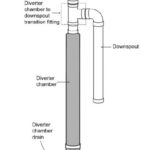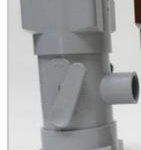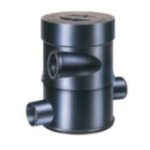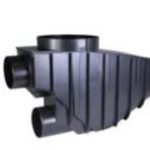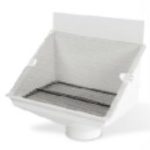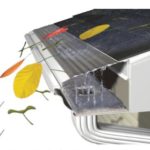Blog
First Flush Devices 08/12/2016
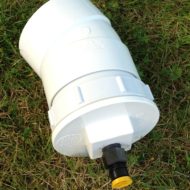
RAINWATER FIRST FLUSH DIVERTER DEVICES
By Sandra Ungerson, AloPluvia IWRM Ltd. August 11,2016
Why do people put first flush diverters in their rainwater systems?
First flush diverters are intended to remove debris, so leaves, needles and such, do not get into your water storage tank. The idea is to divert the first part of the ‘rain event’ containing roof and gutter debris away from the storage vessel, before it can enter your water storage system.
When designing a rainwater harvesting system, it is important to ensure that as little debris as possible gets into your storage tank. When too much debris accumulates, your tank may require professional cleaning.
First Flush devices in theory, allow the first portion of rainfall to run through the first flush device, taking away debris, leaving the main flow of the water virtually debris free. The trick is to find a device that removes debris with the least loss of rainwater. Some devices take significant gallons of rain to remove debris before they re-direct the remaining flow to the tank.
Researchers have considered this question. One particularly notable study found, depending on the device, 5 to 8.5mm of rain must be removed to bring the water to World Health Organization drinking water standard for turbidity, depending on the density of debris on the roof. (Martinson, 2013). This paper also found “most current first-flush devices used in the field have a poor performance” (basic first flush design). Material removal efficiency comes at a cost.
That cost is water. It works just like when you hose down your driveway. The more water you use, the better the cleaning job, depending on the type and density of debris. Locations that have mostly light rainfall events, are not able to deliver sufficient supply to some first flush units to have them function efficiently. A rule of thumb used in the industry is that for every millimeter of rainfall traveling through a first flush device, it has been found that the contaminant load going into the tank will be halved (Martinson D. T., 2005).
What first flush devices can and cannot do
Your collection surface is important. If you have a treated cedar shake roof, a first flush diverter will not solve your problems. If you have an old asphalt shingle roof, a first flush diverter will not solve your problems. If you have a metal, slate or other smooth, non-toxic roof surfaces, a first flush diverter can help. Why? Because first flush diverters have minimal impact reducing chemical toxins found in roofing materials. First flush diverters are meant to catch the first ‘washoff’ a rainfall event causes. This rain washes off the dust, pollen, grit, tree bits, feathers and other such physical debris sitting on the roof. Once this has washed off, the remaining rainfall is diverted into your tank.
Some devices require more maintenance than others. If you have a pipe diverter system attached to the downspout, with a cap or tap attachment, or the unit does not have a float or similar trigger device installed, it must be emptied/cleaned out after a rain event. In the case of the directional diverter you must go out in the rain to engage the system to collect water. These types of devices may not work properly if you have not emptied them before the next rain event occurs.
Knowing this, how can you overcome the obstacles?
- Choose a device that requires less maintenance.
- Consider your roofing material (for more information on this see upcoming article on the subject).
- Consider the debris on your roof or catchment surface. Is it natural organic debris or is it more chemical or microbial. The type of debris will have an impact on your water quality which could limit the use opportunities without further hazard specific treatment.
- Do you have debris sources you can reduce or eliminate on your catchment surfaces first? If you have animals living on, or using your roof as a highway, see if you can install barriers or eliminate easy access to reduce this activity.
- If you have extensive pollen or pitch debris on your catchment surface, this requires more water to remove.
- How intense is your rainfall on average? Do you have a few significant rainfalls, or more frequent lighter rainfalls? The second scenario limits the style of diverter you can use.
- Consider what is available. There are many designs on the market. Here are a few:
Figure 1 – Basic First Flush Device
Figure 2 – Directional Diverter
Figure 3 – Wisy Vortex Filter
Figure 4 – Purain tank, wall and ground installations
Figure 5 – Purain with non-return valve and skimmer overflow
Figure 6 – Rain Heads
Figure 7 – MasterShield & Klean Gutter Guards
They use steel micro-mesh small enough to prevent mosquitos from getting in and there are several different styles available
Consider your options
Each one of these solutions addresses different issues. It is important that you identify your needs before choosing one of these solutions.
Do you need a system that will reduce source pollen and needles? Do you have a lot of small debris getting into your gutters? The MasterShield system (Fig 7) could work very well for you. Do you want access to your first flush device and have more leaves and moderate-to-large debris? A Purain (Fig 4 & 5) system might be your best alternative. The Purain system is also the best system when you have small rain events. Many places have 97% or more of their rainfall classed as small rainfall events. The Purain system consumes about 3% of the water flowing through your system, to operate well. If you have frequent heavy rains and no large debris, then the Wisy filter (Fig 3) could be useful. The system is very efficient once the mesh is fully wet. However, until it is completely wet, the water loss is 25-47% (Jensen, 2002). Some debris can cause the Wisy filter to clog, so fine debris and large sticks and branches must be minimized. All the systems noted in this paragraph are all virtually maintenance-free – if the circumstances meet the product specifications. Even when you meet all the system specification for your device you should still do a seasonal inspection to ensure the system is functioning correctly and nothing has snuck in to clog things up.
Rainheads (Fig 6) and basic diverters require more maintenance, so where you install them they need to be easily accessible. Depending on how much debris you have on your roof, you may have to clean the system monthly. Directional diverters (Fig 2) only re-direct water, they are not genuine first flush devices. There is no debris separation mechanism built-in. If you keep the diverter setting on until it rains, then manually switch over to storage mode, you do have first flush capacity, if you wait for the first bit of rain to run through first. This may not be appealing to most homeowners, however. Basic first flush devices (Fig 1) consume more water than other diverter devices and they do not work well in areas with lighter rainfall patterns. In-Tank filter baskets mounted on the storage devices are another option, however these require significant maintenance and there are additional costs to replace the filters when they wear out.
To get the best value for your money, ask questions, compare your alternatives, then choose a solution that handles the conditions you have and does the job you want your system to do.
To print out a pdf version of this article, click here.

